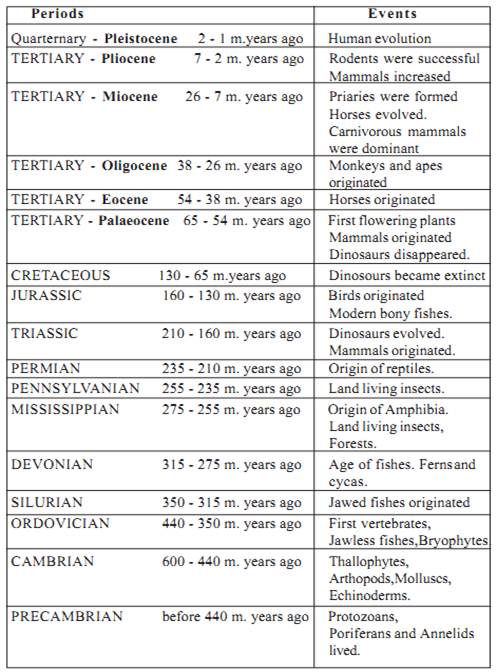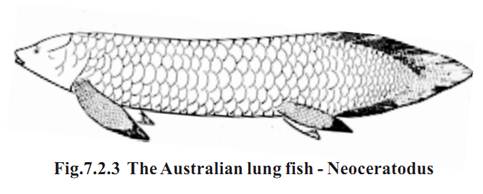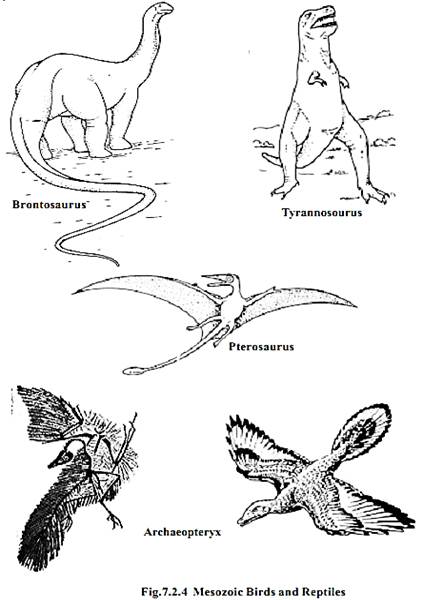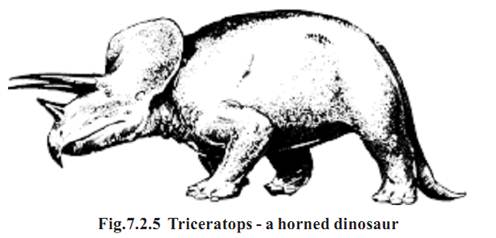


 النبات
النبات
 الحيوان
الحيوان
 الأحياء المجهرية
الأحياء المجهرية
 علم الأمراض
علم الأمراض
 التقانة الإحيائية
التقانة الإحيائية
 التقنية الحيوية المكروبية
التقنية الحيوية المكروبية
 التقنية الحياتية النانوية
التقنية الحياتية النانوية
 علم الأجنة
علم الأجنة
 الأحياء الجزيئي
الأحياء الجزيئي
 علم وظائف الأعضاء
علم وظائف الأعضاء
 الغدد
الغدد
 المضادات الحيوية
المضادات الحيوية|
Read More
Date: 5-11-2015
Date: 5-11-2015
Date: 2-11-2015
|
Geological time scale
The oldest known rocks are about 3.8 billion (3800 million) years old. It corresponds to 38, 000, 000 centuries. According to Geologists and Geophysicists our planet earth is 4.7 billion (4,700 million) years old.
In this ancient time scale evidences showed that the first life originated 2.5billion (2,500 million) years ago. Hence from the formative stage for nearly 2,200 billion years there was no life on earth. Such a period in earth’s history is known as the Azoic era (2,200 to 5,000 billion years ago). Evidences show that during this era the earth was a hot sphere. Gradually the upper surface of the earth cooled down. It resulted in solidification and formation of rocks and rocky terrain. Further water molecules were formed resulting in accumulation of water and water reservoirs as water masses and land surface were established. These transformations provided a suitable condition for the origin of the first life.
Once the life originated and established, evolutionary changes took place. Changes happened in the structure, organization and living methods of organisms, depending on natural surroundings and changes in natural surroundings. Thus fauna and flora started flourishing on earth. The water masses were fully exploited. Later land surfaces were invaded by plants and animals.
The Geological time succeeding Azoic Era, was dramatic and rich in life. This period is divided into three eras. These were significant periods in earth’s history. Of these, the oldest era was the Paleozoic era. It ranged from 600 to 210 million years ago. Thus its duration was nearly 390 million years. This era saw the origin and adaptive radiation of sponges, starfishes, snails, insects, crabs, and terrestialised amphibians and reptiles.
The Paleozoic era was followed by middle period named as Mesozoic era. This era ranged from 65 to 210 million years ago. Its duration was 145 million years. During this era, among animals the reptiles came to prominence. Hence this era is known as the golden age of reptiles. Further this era saw the origin and development of birds and reptiles.
The period ranging from 65 million years till date is named as the Coenozoic era. This era is characterized by rapid evolutionary changes in mammals. This era is known as the Age of mammals.
Geological time scale
A geological calendar has been formulated by assessing the age of rocks and rock sediments. Based on age, and events, the ancient period from

Earth’s history is formulated into eras-periods-epochs. Each division in the geological calender is clearly identified and demarcated. Incidents pertaining to earth surface, plant and animals life are neatly recorded. The influence of geological and climatic changes on the life and the evolution of the living organism had been well analyzed.


I. Paleozoic era: - This era produced revolutionary changes in the biosphere. Further this era saw the origin and the radiation of several groups of animals and plants that remained as the forefathers for the modern groups. Thus this era is known as the Cradle of ancient life.
1-Cambrian period: - (600 to 440 million years ago)
The period preceding cambrian is known as Pre-cambrian period. During precambiran time simple algae, protozoans, poriferans, annelids, were well established. Thus the cambrian started with the plants and animals that were successful during the precambrian period. During cambrian among plants thallophytes were well established. They diversified into various groups. (Chlorophyceae, Rhodophyceae etc.). Among animals the aquatic arthropods and echinoderms came to prominence. The fossils of such organism were obtained from several places.
2-Ordovician period: - (440 to 350 million years ago)

This period was marked by formation of coral rocks and molluscs and echinoderms. Among plants the semi terrestrial bryophytes were getting established. Interestingly this period saw the origin of first vertebrates. These were the now extinct agnatha. (Jawless, armoured fishes). The origin of early vertebrates was the major event that happened in the evolution of animals. Among arthropods, the trilobites were more prominent during this period.
3-Silurian period: - (350 to 315 million years ago)
The oldest land plant originated in this period. These plants possessed conducting tissues. They colonized the land. Among invertebrates except for insects all others flourised. The corals diversified. Several coral islands were formed. Jawed fishes originated. The fishes developed scales and paried fins, for the first time jaws originated in fishes. Origin of paired fins and jaws is considered as major events in chordate evolution.

4-Devonian Period: - (315 to 275 million years ago
It is a significant period in the Paleozoic era. During this period land living plants were more successful. The forests were filled with varieties of ferns and cycas. (Non-flowering plants). Among aquatic animals fishes became dominant. They diversified by adapting themselves to live in various aquatic ecosystems. The forefathers of almost all modern fishes lived during this period. Due to these reasons this period is called as the Age of fishes.
(5-Mississippian Period :- (275 to 255 million years ago

Several changes happened to the land structure. There were massive upraising of land in several places. This resulted in the formation of several mountain ranges. Huge water bodies were broken into smaller lakes. These major changes on earth’s surface were known as revolutions (eg. Caledonian revolution). Such changes were the cause for the origin of lungs in fishes. Lungs evolved for the purpose of living temporarily on land. It helped such fishes to find new water bodies. Such practices encouraged the origin of the amphibians. The origin of land living amphibians were further increased by the proliferation of several land living insects.
6-Pennsylvanian :- (255 to 235 million years ago)
The land living forms became more successful during this period. There were huge forests of ferns and cycas. Due to geotectonic changes several forests got buried under the soil. Today’s coal and petroleum are obtained from such resources only. Hence the Pennsylvanian and the earlier Mississippian were collectively known as Carboniferous (carbon bearing) period.
7-Permian Period :- (235 to 210 million years ago)
It was the last period in the Paleozoic era. This period was marked by extinctions of several older groups of animals and plants. Nearly 60% of the organism that survived at that time became extinct. Some of the amphibians dramatically laid land eggs (cleidoic eggs). Specifically the group of organisms that laid such eggs are identified as Seymouria. These are considered as inter-connecting links between amphibians and reptiles.
II. Mesozoic Era:
This middle period in the history of life was marked by the prominence of land living forms. Among animals the reptiles became more dominant. They increased in size and in number. Hence this era is named as the Golden age of reptiles.
1-Triassic Period: - (210 to 160 million years ago)
For the first time fossils of turtles, crocodiles, and dinosaurs have been obtained from this period. Fossil evidences show that aquatic and flying reptiles thrived during this time. The mammal's originated from reptiles during this period.
2-Jurassic Period: - (160 to 130 million years ago)
There was a marked adaptive radiation among dinosaurs. They diversified into carnivorus and herbivorus forms. The first birds originated from the reptiles. The earliest bird thus originated is known as the Archeopteryx. The origin of birds was a major physiological change among animals. From a more common poikilothermic condition through feathers the birds became homoeothermic.
The modern bony fishes were diversified into several groups.

Cretaceous Period: - (130 to 65 million years ago)
The larger marine molluscs became extinct. The fossils of such or-ganisms are available in places like Ariyaloor, of Tamil Nadu, today
The Dinosaurs of the Mesozoic era abruptly became extinct during this period. Several reasons are given for the extinction of the dinosaurs. Fossils of dinosaurs were not obtained from later periods.
III. Cenozoic Era :- (65 million years ago till date)

Plenty of fossils of organisms belonging to this era had been obtained. All modern animals and plants were represented in these fossils. This era is subdivided into Tertiary and Quaternary periods. Further this era contains seven epochs. Through fossils we can trace the origin and evolution of independent groups of animals, camels and man.
1-Paleocene epoch
Modern placental mammals originated during this time
2-Eocene Epoch
Ungulates originated. The ancestral form of modern horses lived during this epoch.
3-Oligocene epoch
Several animals with ancient characteristics became extinct. Modern mammalian families were established. The apes originated during this epoch.
4-Miocene epoch
Several varieties of grasses evolved in Europe and N. America. Thus large Priaries were formed. These changes encouraged the evolution of fast
Running herbivorus mammals and their predators. Thus the carnivorous mammals came to prominence.
6-Pliocene Epoch
The priaries enlarged still further in several regions. The rodents became more successful. The mammals increased in number.
7-Pleistocene epoch
Several glaciations happened during this time. This epoch is popularly called the ‘Ice age’. The evolution of horses and man reached the final stages during this period. The melting of ice that happened 1,500 years ago is considered as the last stage of this epoch. Today we are living in an inter-glacial Period.
References
T. Sargunam Stephen, Biology (Zoology). First Edition – 2005, Government of Tamilnadu.



|
|
|
|
علامات بسيطة في جسدك قد تنذر بمرض "قاتل"
|
|
|
|
|
|
|
أول صور ثلاثية الأبعاد للغدة الزعترية البشرية
|
|
|
|
|
|
|
مكتبة أمّ البنين النسويّة تصدر العدد 212 من مجلّة رياض الزهراء (عليها السلام)
|
|
|